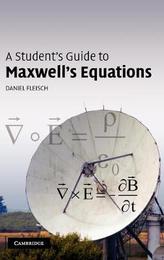
|
A Student's Guide to Maxwell's Equations
Hardback
Main Details
| Title |
A Student's Guide to Maxwell's Equations
|
| Authors and Contributors |
By (author) Daniel Fleisch
|
| Series | Student's Guides |
|---|
| Physical Properties |
| Format:Hardback | | Pages:146 | | Dimensions(mm): Height 235,Width 158 |
|
| Category/Genre | Physics |
|---|
| ISBN/Barcode |
9780521877619
|
| Classifications | Dewey:530.141 530.14/1 |
|---|
| Audience | | Tertiary Education (US: College) | | Professional & Vocational | |
|---|
| Illustrations |
Worked examples or Exercises; 31 Halftones, unspecified; 32 Line drawings, unspecified
|
|
Publishing Details |
| Publisher |
Cambridge University Press
|
| Imprint |
Cambridge University Press
|
| Publication Date |
10 January 2008 |
| Publication Country |
United Kingdom
|
Description
Gauss's law for electric fields, Gauss's law for magnetic fields, Faraday's law, and the Ampere-Maxwell law are four of the most influential equations in science. In this guide for students, each equation is the subject of an entire chapter, with detailed, plain-language explanations of the physical meaning of each symbol in the equation, for both the integral and differential forms. The final chapter shows how Maxwell's equations may be combined to produce the wave equation, the basis for the electromagnetic theory of light. This book is a wonderful resource for undergraduate and graduate courses in electromagnetism and electromagnetics. A website hosted by the author at www.cambridge.org/9780521701471 contains interactive solutions to every problem in the text as well as audio podcasts to walk students through each chapter.
Author Biography
Daniel Fleisch is Associate Professor in the Department of Physics at Wittenberg University, Ohio. His research interests include radar cross-section measurement, radar system analysis, and ground-penetrating radar. He is a member of the American Physical Society (APS), the American Association of Physics Teachers (AAPT), and the Institute of Electronic and Electrical Engineers (IEEE).
Reviews'Professor Fleisch is a great scientific communicator.' electronicdesign.com '... good examples and problems are given so the student can practice the skills being taught.' IEEE Microwave Magazine '... its virtue ... is to address, through judicious selection of material and masterful repetition of important facts, the needs of a student who finds lectures and textbooks hard to understand, too complex, and besides the point of doing the assigned problems. ... Students who are struggling with the material will love the Guide. The Guide is a well-written, concise, honest tool that delivers just what it promises.' American Journal of Physics
|